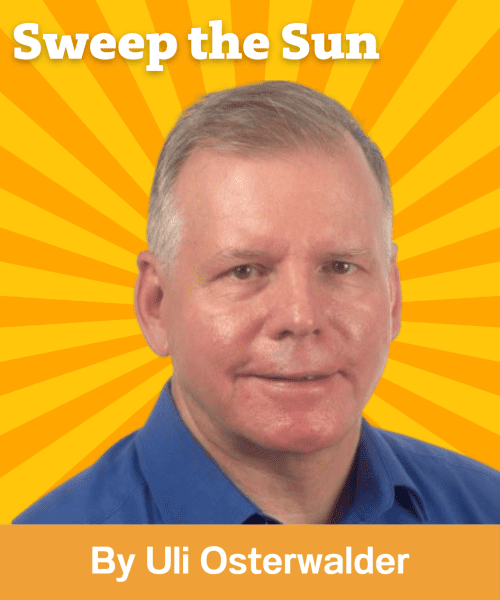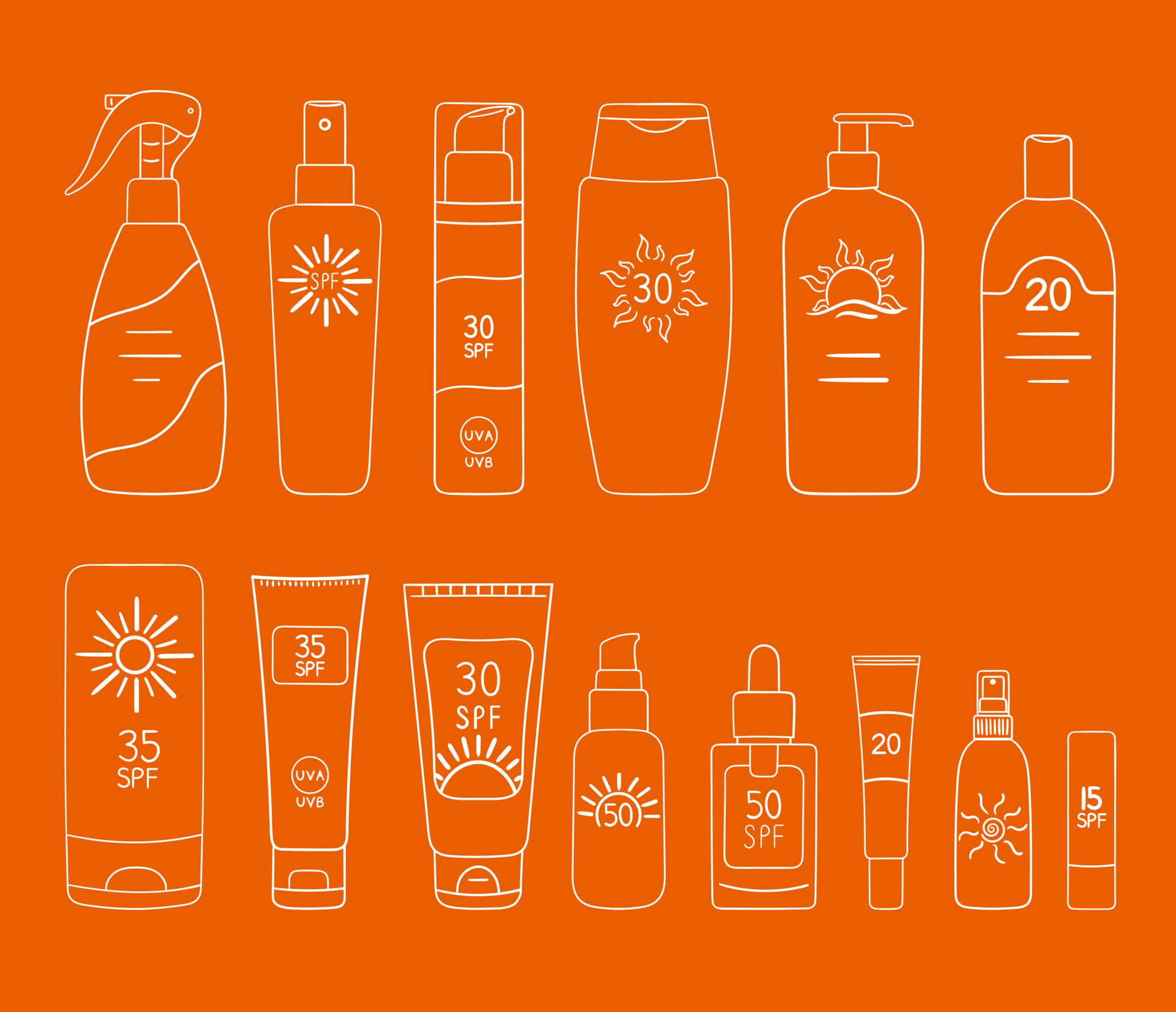
This is the first edition of Sweep the Sun. Let me explain what qualifies me as a writer of a sunscreen column. Being a chemical engineer by training is already useful because all sunscreens are composed of chemicals, whether organic or inorganic. Then comes, of course, my experience; I have worked at the large supplier companies Ciba-SC/BASF and DSM in marketing and as a scientific sunscreen advisor. In addition to our products, especially UV filters, we had to know the needs of our customers in order to develop the right products for the future. Thus, I soon learned the four basic requirements from the largest sunscreen manufacturer, e.g. L’OREAL. Namely: 1) Efficacy, 2) Safety, 3) Registration and 4) Patent freedom, which means “freedom to operate“. In my 20-year career in the sunscreen industry, I have not encountered a single requirement that did not fit into one of these 4 categories1. For example, the price of a UV filter is obviously part of its efficiency. This is often one of the reasons, among others, why “natural filters” are virtually unused in the sunscreen market. These basic requirements determine the value and usefulness of UV filters: the better these basic requirements are met, the higher the value of the UV filter. Another important part is the measurement of the efficacy/ performance of a sunscreen. An ISO working group has been working on SPF standardization since 2006. I have been a mem- ber of this WG7 group, which is part of the technical committee ISO/TC 217 Cosmetics. For the last few years I have also been chair of ISO/TC 217 with its 4 active working groups. The first SPF standard was ISO 24444:2010. Now we have the first re- vised SPF standard, ISO 24444:20192,3. In the meantime, UVA standards, ISO 24442:2011 and ISO 24443:2012, have also been developed. In these Sweep the Sun columns, over the next few months, I will discuss all these aspects, always with a scientific background. We are aware that not all ideas and wishes of the market coincide with the scientific standard. We soon learned to live by the marketing maxim: “the customer’s perception is our reality”. Cernasov and Gurrieri have recently given an idea of the trends in sun protection in EURO COSMETICS4.
Let’s start this first column of Sweep the Sun with the SPF, the sun protection actor. More than 10 years ago Bernd Herzog and I wrote an article entitled: Sun protection Factors: Worldwide Confusion5.
Although we have seen that progress has been made, there is still some confusion, but it is getting less. This is what we wrote in our 2009 summary:
The Sun protection factor (SPF) is a popular tool in sunscreen marketing. Unfortunately, there is often a lack of understanding of how sunscreens work and where the limitations of SPF lie. Many aspects of SPF are confusing, for example, the race to achieve higher and higher values, the effect on SPF when less sun- screen is applied or whether sunscreen should not be used at all because it can block vitamin D synthesis. All this has a negative impact on consumer or patient compliance, which is the most important influencing factor in sun protection. This article explains how sunscreens work, how SPF is determined and what the limitations of current methods are. The dynamic view of the “applied UV radiation” and the “transmitted UV dose” through the sunscreen on the skin as well as on a substrate in vitro help the understanding and are also promising approaches in in vitro evaluation. A variant of the in vitro evaluation of a sunscreen is the in-silico calculation based on the absorption spectrum of UV filters and an assumption about the uneven sunscreen film on the skin. The sunscreen simulator program can be used to determine how the SPF is affected by applying smaller amounts of sunscreen. In addition to SPF, UVA protection is also analyzed. The degree of UVA protection determines the quality of the overall UV protection, while the SPF is an indication of the amount of protection. In addition, other protection factors such as IPF, iSPF, RSF and p53 as well as the inhibition of vitamin D3 synthesis by sunscreens are also ana- lyzed. In conclusion, it is demonstrated that the accuracy and robustness of SPF and other protective factors will be significantly improved with the availability of true broad-spectrum sunscreens rather than conventional UVB-biased sunscreens, as uniform protection profiles lead to protection independent of the endpoint action spectrum and UV radiation source.
The SPF was standardized by ISO in 2010 and subsequently revised for the first time in 2019, resulting in ISO 24444:2019 3. This recent revision should solve many of the problems of the first version in 2010. The biggest challenge is the variability be- tween different laboratories.
ISO 24444:2019: The main changes with respect to the previous edition are as follows:
– The definition of the minimum erythema response criteria (MED) has been revised.
– The choice of eligible test subjects is now based solely on the individual typing angle (ITA°), with the requirement that the mean ITA° of the test panel be within the range of 41° to 55°, with a minimum of three subjects within two of the three ITA° ranges.
– Three new standard reference sunscreens have been validated and added to the method for validating SPF test panels for products with SPF equal to or greater than 25 (P5, P6 and P8).
– Sunscreen application procedures have been described in more detail.
– An informative Annex F has been added with photographic examples of erythema responses with guidelines for their classification.
– The information tables in Annex G) and the requirements in Clause 11 have been modified to provide more complete information on test results.
I am optimistic, I know that we will improve the SPF situation with the revised ISO 24444:2019 gold standard, if the ISO procedure is applied correctly.
In order to prevent that the subjects of both in-vivo measurements (SPF ISO 24444:2019 and UVAPF ISO 24442:2012) are not exposed to potentially harmful radiation anymore, several noninvasive methods have been developed. In sunscreen performance characterization, we are now at a crucial point to substan- tially improve protection information with potentially suitable in-vitro, in-vitro/in-vivo and in-silico methods. More about these alternative SPF methods in the next columns. Stay tuned.

The figure depicts multiple dimensions that are important for determining
whether sunscreens are protective and safe to use. Not all dimensions are in
the committee’s scope to review, which is focused on environmental protection
and efficacy in protecting human health.
To wrap up this first edition of the Sweep the Sun column, I’d like to give you a little preview of what’s to come:
There are three general issues surrounding sunscreens at the consumer level: 1) Effectiveness (do they work), 2) Safety (can they do harm) and 3) Trust (who can I believe). The general ap- proach to answering all of these questions: Science. However, when science lags a bit behind, because extensive research takes time, half-truths and misinformation are spreading, often driven by marketing claims. As an example, take sun protection and the environment. There were only few early studies, e.g. by Roberto Danovaro6 and by Craig Downs7, but they did already lead to legislative action in some countries. Science is catching up. The National Academy of Sciences (NAS) has just published a very comprehensive 400-page report on this topic8. It basically says that a total ban on some sunscreens is not warranted based on currently available data, but that Environmental Risk Assessments (ERAs) should be conducted on a case-by-case basis. The NAS report summarizes all desirable characteristics of sunscreens for humans and the environment (see figure).
In Europe we have a well-established system of safety and en- vironmental assessment, with the SCCS in Brussels9 and ECHA in Helsinki10, and the European Commission deciding what is allowed on the market, after consultation with all EU member states. Gerald Renner wrote an excellent review about the regulatory situation in Europe11. Legislation takes some time, so it may make sense to act immediately. This requires using common sense; for example, while snorkeling on coral reefs, it may be wise not to use any sunscreen at all, while protecting yourself from the sun as a tourist in Paris, France, will not harm any coral, regardless of the sunscreen you use.
References:
1 Hanay C, Osterwalder U. Challenges in Formulating Sunscreen Products. Curr Probl Dermatol. 2021;55:93-111. doi: 10.1159/000517655.
2 Surber C, Uhlig S, Bertrand C, Vollhardt J, Osterwalder U. Past, Present, and Future of Sun Protection Metrics. Curr Probl Dermatol. 2021;55:170-187. doi: 10.1159/000517667.
3 INTERNATIONAL STANDARD, ISO 24444, Cosmetics – Sun protection test methods – In vivo determination of the sun protection factor (SPF), Second edition, 2019-12
4 Domnica Cernasov and Bérengère Gurrieri, Sun Care Market Trends – Meet- ing the Challenges 2022 and Beyond, Euro Cosmetics 2022-06
5 Osterwalder U, Herzog B. Sun protection factors: world wide confusion. Br J Dermatol. 2009 Nov;161 Suppl 3:13-24
6 Danovaro R, Bongiorni L, Corinaldesi C, Giovannelli D, Damiani E, Astolfi P, et al. Sunscreens cause coral bleaching,by promoting viral infections. En- vironHealth Perspect. 2008;116(4):441–7, doi: 10.1289/ehp.10966
7 Downs CA, Kramarsky-Winter E, Segal,R, Fauth J, Knutson S, Bronstein O, et al. Toxicopathological effects of the sunscreen UV filter, oxybenzone (ben- zophenone-3), on coral planulae and cultured primary cells and its environ- mental contamination in Hawaii and the U.S. Virgin Islands. Arch Environ Contam Toxicol. 2016;70:265–88. doi: 10.1007/s00244-015-0227-7
8 National Academy of Science (NAS) Review of Fate, Exposure, and Effects of Sunscreens in Aquatic Environments and Implications for Sunscreen Usage and Human Health (2022), , Study 2022
9 SCCS Scientific Committee on Consumer Safety, https://health.ec.europa.eu/ scientific-committees/scientific-committee-consumer-safety-sccs/sccs-opin- ions_en
10 ECHA, Community rolling action plan update covering the years 2022, 2023 and 2024, https://echa.europa.eu/documents/10162/879660/corap_ update_ 2022-2024_en.pdf/13898cd4-e4ce-4448-fe7a-0e5027156043?t= 1647951716519 , 22 March 2022
11 Renner G, Regulation of Sun Protection Products in the EU, Surber C, Oster- walder U (eds): Challenges in Sun Protection. Curr Probl Dermatol. Basel, Karger, 2021, vol 55, pp 266–281. doi: 10.1159/000517637

Uli Osterwalder
Uli Osterwalder studied Chemical Engineering at ETH Zurich, Switzerland and at the University of Houston in Houston, Texas. He joined Ciba-Geigy in Basel in 1979 where he first developed a Phosgene Generator in central process development. Later he developed his leadership skills in Project Management and Process Analytics. At Ciba Specialty Chemicals Uli Osterwalder helped establish new business development in Fabric Care and Personal Care. After the acquisition by BASF SE he became Senior Marketing Manager and Scientific Adviser in Sun Care in Ludwigshafen and Duesseldorf.
2016 he came back to Basel, working for DSM as senior Senior Scientific Adviser suncare for two years. 2018 he started his own company, Sun Protection Facilitator GmbH and is committed to contribute to further improvements in sun protection. Uli Osterwalder works for ISO on the development of new UV protection assessment methods and is now chairing the technical committee ISO TC/217 (Cosmetics). He is author and co-author of numerous scientific articles and book chapters on sun protection.



